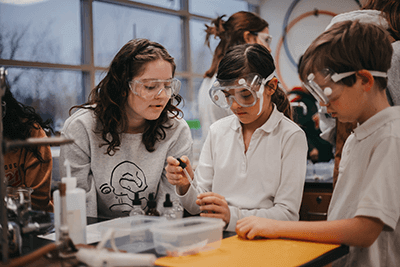February 16, 2023
 from Bill Hudson, head of school
from Bill Hudson, head of school
In high school, science was not my strong suit. Although I did well, I was only really passionate about science in my senior year when I discovered physics. It was a watershed moment for me, and physics helped me to develop a genuine interest in and true passion for science. I only wish I had it earlier in my academic career. Forty years later, I’m happy that today’s students have opportunities I didn’t.
The Upper School science curriculum has undergone a well-planned, research-based evolution over the last four years. The new science curriculum is a comprehensive program that coordinates mathematics with science as a coherent whole with a distinct view of how each concept builds a framework upon previous learning. Physics, traditionally taught in twelfth grade, is now taught in the ninth-grade year. Biology is taught in the sophomore year and chemistry in the junior year. This new sequence now allows for a series of science electives to be offered in the senior year, building upon this new scope and sequence. The new electives give students a choice and the ability to go deeper into a particular field of science.
Since the late 1800s, the secondary science curriculum of biology, chemistry, and physics was created to meet the needs of society and industry. Some say the order was more of a convenience based on no more than the alphabet. In the last two decades, again based on the needs of society and industry, the order was re-sequenced to build a stronger foundation for STEM: science, technology, engineering, and mathematics. The change was also grounded in developments in biology, as it moved from a focus on zoology to one on molecular biology; and the recognition that studying physics could serve as a solid foundation for later biology and chemistry courses.
According to Marc Shapiro, Upper School physics teacher, the substantial additional benefit of moving physics to ninth grade was the opportunity to teach more science electives to students. There are now nine senior science electives to choose from. This school year, the science department added environmental chemistry, astronomy, neuroscience, and advanced Physics courses, with the potential for more courses to be added in the future. This is the first year of these new electives, and they have already proven very popular. The department also opened additional sections of the very popular electives anatomy and physiology and environmental science.
MPA requires students to take three years of science, but approximately 99% of this year’s seniors are taking a fourth year. Upper School science teacher Hannah Sullivan said that many are taking three to four of the half-semester courses or more. Nine electives were offered, and based on student interest, four are being offered this year. Ten seniors are currently enrolled in astronomy with Mr. Shapiro, 16 in advanced physics also with Mr. Shapiro, 23 in environmental chemistry, and 28 students in two sections of neuroscience, all with Ms. Sullivan. Other electives include advanced topics in chemistry, anatomy and physiology, biotechnology, Earth, atmosphere, and planetary science, and environmental science.
Senior Kensi Binstadt chose to take neuroscience, “because I knew it would be a deep dive into a specific topic, and Ms. Sullivan told me it would be engaging with labs, dissections, and would be more than just memorization,” she said. Now that Kensi is in the midst of the course, she is very happy with her choice. “Personally, I really enjoy dissections and hands-on learning because it makes concepts stick in my brain, and it’s exciting to explore and experiment on ourselves while gaining a new understanding of how our brain functions. Because so much is still unknown about the brain, the ongoing investigations and complexity for future exploration also make it fascinating.”
What hasn’t changed in the evolution of our science curriculum is our unique philosophy of engaging students in applying the scientific method, principles, and research to real-world problems and nurturing essential competencies and skills. By taking an inquiry-based approach, students working individually or collaboratively come to understand how content is valuable and can be applied to everyday problems, both large and small.
“I’m taking environmental science because I’m interested in learning about climate change and green energy sources,” said senior Nicholas Larson. “I think global warming will be a prominent topic for my generation, and I want to be an informed contributor to what is done in the future regarding the environment.” Students like Nicholas embody our goal of cultivating citizen scientists. By nurturing their knowledge and scientific literacy, they become active participants in society no matter their chosen profession. With the pace of scientific discovery accelerating exponentially, MPA students will graduate with the strong science foundation necessary to live, learn, and thrive.